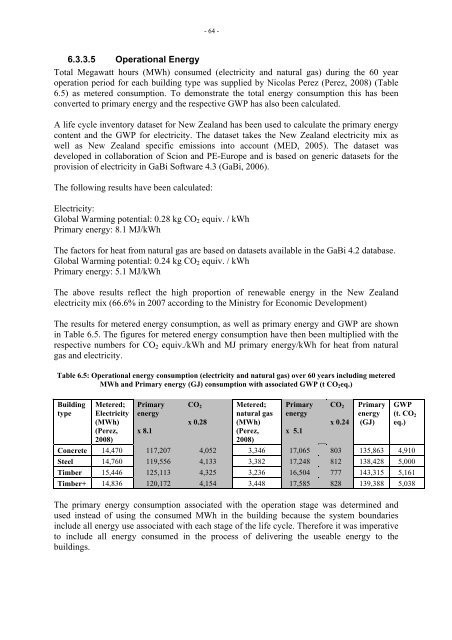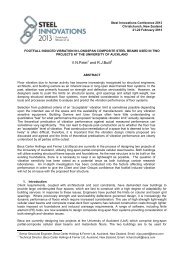Environmental Impacts of Multi-Storey Buildings Using Different ...
Environmental Impacts of Multi-Storey Buildings Using Different ...
Environmental Impacts of Multi-Storey Buildings Using Different ...
Create successful ePaper yourself
Turn your PDF publications into a flip-book with our unique Google optimized e-Paper software.
- 64 -6.3.3.5 Operational EnergyTotal Megawatt hours (MWh) consumed (electricity and natural gas) during the 60 yearoperation period for each building type was supplied by Nicolas Perez (Perez, 2008) (Table6.5) as metered consumption. To demonstrate the total energy consumption this has beenconverted to primary energy and the respective GWP has also been calculated.A life cycle inventory dataset for New Zealand has been used to calculate the primary energycontent and the GWP for electricity. The dataset takes the New Zealand electricity mix aswell as New Zealand specific emissions into account (MED, 2005). The dataset wasdeveloped in collaboration <strong>of</strong> Scion and PE-Europe and is based on generic datasets for theprovision <strong>of</strong> electricity in GaBi S<strong>of</strong>tware 4.3 (GaBi, 2006).The following results have been calculated:Electricity:Global Warming potential: 0.28 kg CO 2 equiv. / kWhPrimary energy: 8.1 MJ/kWhThe factors for heat from natural gas are based on datasets available in the GaBi 4.2 database.Global Warming potential: 0.24 kg CO 2 equiv. / kWhPrimary energy: 5.1 MJ/kWhThe above results reflect the high proportion <strong>of</strong> renewable energy in the New Zealandelectricity mix (66.6% in 2007 according to the Ministry for Economic Development)The results for metered energy consumption, as well as primary energy and GWP are shownin Table 6.5. The figures for metered energy consumption have then been multiplied with therespective numbers for CO 2 equiv./kWh and MJ primary energy/kWh for heat from naturalgas and electricity.Table 6.5: Operational energy consumption (electricity and natural gas) over 60 years including meteredMWh and Primary energy (GJ) consumption with associated GWP (t CO 2 eq.)BuildingtypeMetered;Electricity(MWh)(Perez,2008)Primaryenergyx 8.1CO 2x 0.28Metered;natural gas(MWh)(Perez,2008)Primaryenergyx 5.1CO 2x 0.24Primaryenergy(GJ)GWP(t. CO 2eq.)Concrete 14,470 117,207 4,052 3,346 17,065 803 135,863 4,910Steel 14,760 119,556 4,133 3,382 17,248 812 138,428 5,000Timber 15,446 125,113 4,325 3,236 16,504 777 143,315 5,161Timber+ 14,836 120,172 4,154 3,448 17,585 828 139,388 5,038The primary energy consumption associated with the operation stage was determined andused instead <strong>of</strong> using the consumed MWh in the building because the system boundariesinclude all energy use associated with each stage <strong>of</strong> the life cycle. Therefore it was imperativeto include all energy consumed in the process <strong>of</strong> delivering the useable energy to thebuildings.
















